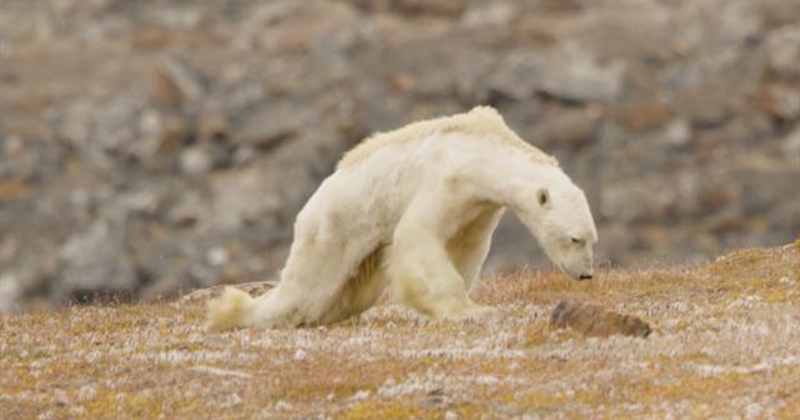Photojournaliste pour National Geographic, Paul Nicklen est spécialiste des ours et s’est associé à l’association SeaLeagcy qui a pour mission de protéger les océans, pour réaliser un documentaire autour du réchauffement climatique. Et s’ils avaient conscience des dégâts que ce phénomène pouvait inclure a fortiori sur l’espèce animale, ils n’étaient pas préparés à cette bouleversante rencontre.
« Nous étions là à pleurer en train de filmer avec des larmes qui roulaient sur nos joues » a-t-il expliqué sur son compte Instagram, décrivant un souvenir qui le « hante ».
La vidéo est crue mais réelle. Elle montre un ours polaire émacié qui se déplace difficilement, donnant à sa vie un sens prépondérant malgré son ossature plus que fine et l’une de ses pattes arrière qui semble s’apparenter à une atrophie musculaire. L’ours a faim et cherche de la nourriture comme l’on pourrait chercher une aiguille dans une botte de foin. Il ne trouve rien mis à part une poubelle où se trouvent les déchets. Las, il s’effondre. Résigné. « Il n’était pas vieux mais est probablement mort dans les heures qui suivaient » pense le photographe.
My entire SeaLegacy team was pushing through their tears and emotions while documenting this dying polar bear. It’s a soul-crushing scene that still haunts me, but I know we need to share both the beautiful and the heartbreaking if we are going to break down the walls of apathy. This is what starvation looks like. The muscles atrophy. No energy. It’s a slow, painful death. When scientists say polar bears will be extinct in the next 100 years, I think of the global population of 25,000 bears dying in this manner. There is no band aid solution. There was no saving this individual bear. People think that we can put platforms in the ocean or we can feed the odd starving bear. The simple truth is this—if the Earth continues to warm, we will lose bears and entire polar ecosystems. This large male bear was not old, and he certainly died within hours or days of this moment. But there are solutions. We must reduce our carbon footprint, eat the right food, stop cutting down our forests, and begin putting the Earth—our home—first. Please join us at @sea_legacy as we search for and implement solutions for the oceans and the animals that rely on them—including us humans. Thank you to our angel donors for your love and support and for keeping our team on location. With Cristina Mittermeier #turningthetide with SeaLegacy: www.SeaLegacy.org(This video is exclusively managed by Caters News. To license or use in a commercial player please contact info@catersnews.com or call +44 121 616 1100 / +1 646 380 1615)
Publiée par Paul Nicklen Photography sur Mardi 5 décembre 2017
Juste pour info :
« Il y a 93% de chances que le réchauffement dépasse 4°C d’ici la fin du siècle », a affirmé Ken Caldeira dans un communiqué de presse. Ce qui constitue une probabilité plus élevée que celle avancée par le Groupe d’experts intergouvernemental sur l’évolution du climat (Giec) (3,2%)

